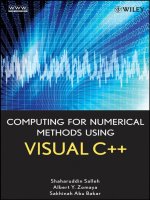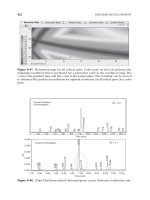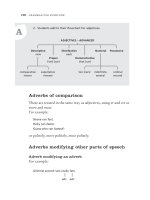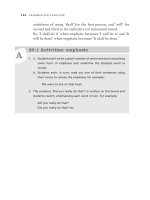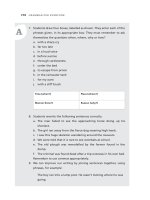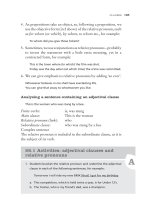Tài liệu Grammar for writing: supporting pupils learning EAL doc
Bạn đang xem bản rút gọn của tài liệu. Xem và tải ngay bản đầy đủ của tài liệu tại đây (471.12 KB, 112 trang )
Curriculum, Examination
& Assessment
English Consultants
and EAL Coordinators
Status: Recommended
Date of issue: 11/02
Ref: DfES 0581/2002
Key Stage 3
National Strategy
Grammar for writing:
supporting pupils
learning EAL
Guidance
Department for Education and Skills
Sanctuary Buildings
Great Smith Street
Westminster
London
SW1P 3BT
Ref: DfES 0581/2002
© Crown copyright 2002
Produced by the Department for Education and Skills
Extracts from this document may be reproduced
for non-commercial or training purposes on the
condition that the source is acknowledged
www.dfes.gov.uk
www.standards.dfes.gov.uk/keystage3
CPM 10/02
Key Stage 3
National Strategy
Grammar for writing:
supporting pupils learning EAL
Grammar for writing: supporting
pupils learning EAL
All contents of this folder are available on the DfES Key Stage 3 website:
/>1
Grammar for writing: supporting pupils learning English as an additional language © Crown copyright 2002
Contents
Acknowledgements 3
Aims 4
Pre-course task 5
Suggested timings 6
Session 1 Introduction 7
OHTs 1.1–1.14 16
Handout 1.1 30
Session 2 Text cohesion 31
OHTs 2.1–2.9 40
Handouts 2.1–2.5 49
Session 3 Sentence construction and subordination 55
OHTs 3.1–3.7 61
Handouts 3.1–3.3 68
Session 4 Word choice and modification 71
OHTs 4.1–4.11 77
Handouts 4.1–4.3 88
Session 5 Assessing pupils’ writing and teaching grammar in context 91
OHT 5.1 93
Handouts 5.1–5.6 94
Session 6 Post-course tasks and evaluation 103
OHTs 6.1–6.2 104
Handouts 6.1–6.2 106
Appendix Key grammatical terms with examples 109
2
Grammar for writing: supporting pupils learning English as an additional language © Crown copyright 2002
Acknowledgements
The authors would like to thank the following for their helpful advice and use of materials:
Professor Richard Hudson
Dr Lynne Cameron (University of Leeds)
NALDIC Committee members
Pupils learning EAL and their teachers from schools in the following LEAs: Barking and
Dagenham, Camden, Greenwich, Rotherham and Tower Hamlets.
Grammar for writing: supporting pupils learning English as an additional language © Crown copyright 2002
3
Aims
■ To update Ethnic Minority Achievement (EMA) teachers on the approaches to
teaching grammar in Key Stage 3, including current terminology.
■ To consider how focused teaching of grammar can improve the writing of pupils
learning English as an additional language (EAL).
4
Grammar for writing: supporting pupils learning English as an additional language © Crown copyright 2002
Pre-course task
Estimated time to complete task: 30 minutes
Participants will need to gather the following information in preparation for the course and
to bring it with them, as it will be used during the training (session 5).
■ Six to eight samples of extended writing from pupils learning EAL who are working
at NC Levels 3 and 4, in Years 7, 8 and 9.
■ Several medium-term plans for English, mapped against the Framework
objectives.
Note to tutors
This pre-course task will need to be sent to course participants approximately two weeks
prior to the training.
5
Grammar for writing: supporting pupils learning English as an additional language © Crown copyright 2002
Suggested timings
Pre-course task: 30 minutes
9:00 Coffee/arrival
9:15 Session 1 Introduction
10:00 Session 2 Text cohesion
11:00 Coffee
11:30 Session 3 Sentence construction and subordination
12:10 Session 4 Word choice and modification
12:45 Lunch
1:45 Session 5 Assessing pupils’ writing and teaching grammar
in context
2:45 Tea
3:00 Session 6 Post-course task and evaluation
3:30 Close of day
6
Grammar for writing: supporting pupils learning English as an additional language © Crown copyright 2002
Introduction 45 minutes
Resources
OHTs 1.1–1.14
Handout 1.1
One whiteboard per participant
Timing
1.1 Grammar: a focus on pupils learning EAL 10 minutes
1.2 Grammars: what is distinctive about the writing of
pupils learning EAL? 10 minutes
1.3 A shared terminology: word classes in English 20 minutes
1.4 So why teach grammar? A summary 5 minutes
1.1 Grammar: a focus on pupils learning EAL 10 minutes
Begin the session by displaying OHT 1.1, which states the aims of session 1.
Next show OHT 1.2.
Make the following points:
■ An understanding of English grammar will support pupils as readers and writers.
■ Draw attention to how writers (and speakers) use language to influence us as
readers, and that this is vital for critical reading of texts.
■ Point out that it will help pupils to create the effects they want as writers and
speakers.
7
1
Grammar for writing: supporting pupils learning English as an additional language © Crown copyright 2002
Aims
■ To consider how pupils learning EAL may benefit from a focus on
English grammar.
■ To make a case for use of a common terminology.
■ To explain the structure and organisation of the following sessions.
OHT 1.1
Why teach grammar?
■ freedom
■ control
■ choice
■ focused critical reading
■ effective speaking and listening
OHT 1.2
State that these notions are not new. Display OHT 1.3 and ask participants whether they
recognise the following extract. Make sure that the source, at the bottom of the OHT, is
covered at first.
Additional points to make
Learning grammar will:
■ help pupils to transfer and compare their understanding of grammars from their
other languages, when learning how grammar works in writing in English
■ extend pupils’ choices and freedom to express themselves powerfully as writers
■ develop use of English for academic purposes to raise attainment of able pupils
learning EAL who may be otherwise hindered by their lack of English grammatical
knowledge
■ develop pupils’ written repertoire beyond social everyday informal ‘retelling’, into
curriculum genres of explanation, argument and critical analysis.
1.2 Grammars: what is distinctive about
the writing of pupils learning EAL?
10 minutes
Now refer to the samples of pupils’ written work brought by participants as part of the
pre-course task. Say they will use them later in the day, in session 5.
Acknowledge that the writing of pupils learning EAL will show many of the same problems
as that of native English-speaking pupils. For example, both groups may demonstrate
limited use of paragraphs and poor punctuation or spelling.
Explain that the challenge for teachers is to acknowledge important differences in the
nature of problems with sentence grammar, in order to help pupils learning EAL to
demonstrate their capabilities and reflect their thinking and ideas effectively.
State that not every single aspect of grammar is covered in this training: the focus is on
the teaching points that are likely to move pupils’ writing forwards.
8
Grammar for writing: supporting pupils learning English as an additional language © Crown copyright 2002
Grammar is a means of enabling pupils to devote more control and choice in
their use of language. The more we know about grammar, the better equipped
we are to:
■ draw attention to how writers use language to influence us as speakers
and readers
■ help pupils use language to create the effects they want in speaking and
writing.
We all have ‘knowledge about grammar’, but it is useful to review our
knowledge and understanding to establish consistency and to fill in gaps.
At Key Stage 3, grammar is primarily a means of ensuring that pupils become
more skilful and confident in their use of language, and particularly in writing.
The end should be writing which is ‘committed, vigorous, honest and
interesting All good classroom practice will be geared to encouraging and
fostering these vital qualities.’
English for ages 5–16 (Cox Report), 1989
OHT 1.3
Display OHT 1.4.
Additional points to make
■ Compared to native English users, pupils learning EAL lack extensive experience
of using and hearing English.
■ However, they bring previous language learning and experience to the process of
learning English.
■ The particular rate and sequence of learning will depend on many factors:
– prior knowledge
– explicit teaching
– the context and motivation to learn
– opportunities to practise.
Now display OHT 1.5, which outlines the knowledge and expertise that pupils learning
EAL have.
9
Grammar for writing: supporting pupils learning English as an additional language © Crown copyright 2002
Common weaknesses and errors in writing by EAL learners
Text cohesion
■ verb tense forms
■ pronoun ambiguity
■ use of connectives
Sentence construction (subordination)
■ subject-verb agreement
■ word order
■ lack of subordination
Word choice
■ modification
■ use of prepositions
■ use of determiners
OHT 1.4
What pupils learning EAL bring to the process
They will bring:
■ knowledge of fluent talk in their first language(s)
■ commitment and purpose
■ openness to all kinds of new input
■ understanding that languages and grammars differ
■ sometimes, written knowledge of other languages.
In addition, pupils learning EAL are likely to develop a greater knowledge and
understanding of grammars and how they work than their monolingual peers.
OHT 1.5
Task: Supportive features of the KS3 Strategy
Ask participants to discuss briefly in pairs what features of the KS3 Strategy are already
supportive to pupils learning EAL. Allow 1 or 2 minutes, then take brief feedback. Display
OHT 1.6 which lists the features.
Additional points to make
Teachers can:
■ use modelling to point out existing or new patterns in grammar and to explain the
conventions of texts
■ use guided sessions to:
– check understanding
– encourage use and experimentation with conventions
– correct errors and praise success
■ use assessment for learning to set clear and shared targets for improvement.
1.3 A shared terminology: word classes in English
20 minutes
Begin the session by pointing out the following:
■ A shared terminology supports conversations between teachers and pupils about
the ways in which the English language works across the key stages.
■ It engages pupils in discussion about similarities and differences between English
and other languages.
■ Talking about languages, and their patterns and features, explicitly helps pupils to
a more conscious awareness of how they work.
■ Pupils will be better able to use features of English as tools for thinking, expressing
and demonstrating their ideas at a personal and academic level.
At this point, refer to the glossary in the Appendix, taken from the English training file
(2001). Explain that the terminology included is used in Key Stages 1 and 2 (and was
introduced in the Grammar for Writing Module), and has also been shared with Key Stage
3 English teachers who have participated in Module 10 of the English training: ‘Sentence
level: grammar for writing’.
10
Grammar for writing: supporting pupils learning English as an additional language © Crown copyright 2002
Common features in all strands of the KS3 Strategy
■ Structured lessons draw in pupils from the start.
■ Active and engaging tasks which encourage all pupils to participate.
■ Teaching and learning strategies that are active and oral.
■ An emphasis on short-term planning includes planning for input and
support from other adults in the classroom to ensure learning
opportunities are maximised.
■ Subject-specific language skills and conventions of particular forms of
writing are made explicit and demonstrated by the teacher.
■ Planned opportunities for oral rehearsal in pairs and small groups.
■ A requirement that pupils apply learning, supported by group work,
before moving to independent activity.
OHT 1.6
Handout 1.1
Next distribute Handout 1.1 and display OHT 1.7.
Give participants a few moments to read the chart and then make the following points:
■ There are eight ‘word classes’ (used because it gives a more accurate definition
than ‘parts of speech’, as speech also contains phrases and sentences).
■ Most of the terms used will be familiar; determiner may be known by other labels,
e.g. article (articles are included in determiners, even though they do not serve the
same function).
■ Most importantly, pupils who have attended primary schools will already be familiar
with some of the terms.
Task: identifying word classes in sentences
Write the sentence below on an OHT/flipchart and ask participants to identify:
■ two prepositions
■ a subordinating conjunction
■ four determiners (the, a, their, the).
The pupils rushed around a corner, as their teacher
appeared in the playground.
Now, distribute whiteboards to participants and ask them to work in pairs. Explain that
their task is to write two or more sentences, each of which contains: a preposition, a
conjunction, a pronoun and an adverb.
11
Grammar for writing: supporting pupils learning English as an additional language © Crown copyright 2002
OHT 1.7
word
noun pronoun determiner adjective preposition verb adverb conjunction
Np d A p VAv c
he the big of quickly
himself a/an sensible in soon
his which fatal after probably
who this despite
common proper auxiliary full coordinating subordinating
hat John be see and if
invitation London have start or because
hour Saturday will hit but after
Next, ask participants to underline and label the words using the notation on
Handout 1.1. Allow 5 minutes for the task, and then display OHT 1.8.
Take brief feedback, and then display OHT 1.9 to summarise the task.
Additional points to make
Each word class is defined by different characteristics:
■ meaning (semantics): e.g. ‘tie’ could mean to ‘bind up’ or an item of clothing
worn at the neck of a shirt
■ syntax: how a word combines with others; word order in English differs from that
in other languages
■ morphology: how words are built up of smaller meaningful parts (morphemes):
un-faith-ful; in-fidel-ity
■ word families: how words link from their etymology (derivation) to make lexical
patterns and different word classes, e.g. word webs: family, familiar, familiarise.
Now display OHT 1.10.
12
Grammar for writing: supporting pupils learning English as an additional language © Crown copyright 2002
■ How did you generate your examples?
■ How did you decide which class a word belongs to?
■ How could this knowledge help pupils learning EAL improve their reading
and writing?
■ How might this be taught?
OHT 1.8
In English, each word class is defined by:
■ meaning (semantics)
■ syntax
■ morphology
■ word families.
OHT 1.9
Therefore, for each word, we have to decide:
■ What does it mean?
■ How does it link with other words?
■ What job does it do?
■ Where can it go in a sentence?
OHT 1.10
Next, explain that languages do not all have the same structure, for example Finnish does
not have prepositions, and French and Bengali do not have the same word order. This
may present additional problems for pupils learning EAL. Display OHT 1.11, and ask
participants to consider the examples.
Additional points to make
Even young pupils already implicitly ‘know’ word classes because they apply them in
speech, for example, the ‘rules’ of pluralisation in English. Errors sometimes reflect an
over-generalisation of the ‘rules’, for example runned (ran).
Native English-speaking Key Stage 3 pupils are expert users of grammar and rarely use
words of the wrong class, except where this relates to dialect. They may not be sufficiently
explicitly aware to exploit a wider range of language effects in their writing.
Pupils learning EAL need to understand how English grammar works in order to become
effective readers and writers in the target language for learning in the curriculum. Their
writing in English reflects misunderstandings, which in some cases reflect the patterns of
their first languages. Explicit teaching of English grammar will help them to understand it
better.
Many English words can belong to different word classes without a change in form, for
example book (verb or noun).
Words in English are slippery, and their meanings and classes always need to be
considered in the context of their semantic relationships. Words also often have other
subject-specific meanings that differ from their everyday meanings within the Key Stage 3
curriculum. For example bias in history, and bias in textiles, DT.
Task: creating sentences
Finally, divide the participants into two groups. Explain that, working in pairs, group ‘A’ are
quickly going to compose three sentences using the word ‘bank’ in three different ways
and, similarly, group ‘B’ are going to compose three sentences using the word ‘green’.
13
Grammar for writing: supporting pupils learning English as an additional language © Crown copyright 2002
Some examples of syntax in other languages
Spanish
Diana ha escrito hoy una carta larga
(Diana has written today a letter long)
Diana has written a long letter today (English)
Turkish
Ahmad bu askam lakanta-de ban-a kurmizi kitab-i Verdi
(Ahmad this evening restaurant-in me-to red book-the gave)
Ahmad gave the red book to me at the restaurant this evening (English)
Bengali
Se e-le ami misti am taratari kha-i
(he come-when I sweet mango quickly eat)
When he comes I quickly eat a sweet mango (English)
OHT 1.11
After a minute or two, take brief feedback, sharing sentences that have been created.
Draw participants’ attention to the fact that the activity underlines that word meaning is
dependent on context: simply generating words in sentences has limitations.
Therefore, an important teaching strategy is to identify word classes by annotating and
discussing them in the context of a piece of text as well as encouraging pupils to apply
their knowledge in meaningful writing activities.
1.4 So why teach grammar? A summary
5 minutes
Begin the session by displaying OHT 1.12.
Point out that a working knowledge of English grammar is important in supporting the
ability to control and vary writing at text, sentence and word level.
Next, explain these categories, stating why they are important:
■ text: the ability to read and write cohesive chronological and non-chronological
texts (the glue that holds the whole piece together)
■ sentence: the ability to notice, construct, control, punctuate and vary sentence
types
■ word: the ability to control, select, spell and vary vocabulary to create impact in
relation to purpose and audience.
To reinforce this, display OHT 1.13, stating that the following three sessions will focus on
these particular areas.
Point out that, since these aspects of writing are particularly problematic for EAL learners,
they will form the focus for the rest of the training session.
Tell participants that examples of the work of pupils learning EAL are given together with
some consideration of what the pupils know and need to learn.
Tell participants that they will have the opportunity to analyse the work they brought, and
to plan specific activities to help pupils learning EAL improve their writing in context
through a better understanding of how aspects of grammar work in English.
14
Grammar for writing: supporting pupils learning English as an additional language © Crown copyright 2002
Grammar is what gives sense to language … sentences make words yield up
their meanings. Sentences actively create sense in language and the business
of the study of sentences is the study of grammar.
David Crystal
OHT 1.12
The following three sessions focus on:
■ text cohesion
■ clause construction and subordination
■ word modification.
OHT 1.13
Summarise this session with a reminder of why grammar is important: display OHT 1.14.
15
Grammar for writing: supporting pupils learning English as an additional language © Crown copyright 2002
■ Tools not rules.
■ Reading as a writer (increasing critical awareness).
■ Writing as a reader (awareness of the audience).
■ Extending pupils’ authorial choices and freedom as writers.
OHT 1.14
16
Grammar for writing: supporting pupils learning English as an additional language © Crown copyright 2002
OHT 1.1
Aims
■ To consider how pupils learning EAL may
benefit from a focus on English grammar.
■ To make a case for use of a common
terminology.
■ To explain the structure and organisation of
the following sessions.
17
Grammar for writing: supporting pupils learning English as an additional language © Crown copyright 2002
OHT 1.2
Why teach grammar?
■ freedom
■ control
■ choice
■ focused critical reading
■ effective speaking and listening
18
Grammar for writing: supporting pupils learning English as an additional language © Crown copyright 2002
OHT 1.3
Grammar is a means of enabling pupils to devote
more control and choice in their use of language.
The more we know about grammar, the better
equipped we are to:
■ draw attention to how writers use language to
influence us as speakers and readers
■ help pupils use language to create the effects
they want in speaking and writing.
We all have ‘knowledge about grammar’, but it is
useful to review our knowledge and understanding
to establish consistency and to fill in gaps.
At Key Stage 3, grammar is primarily a means of
ensuring that pupils become more skilful and
confident in their use of language, and particularly
in writing. The end should be writing which is
‘committed, vigorous, honest and interesting
All good classroom practice will be geared to
encouraging and fostering these vital qualities.’
English for ages 5–16 (Cox Report), 1989
19
Grammar for writing: supporting pupils learning English as an additional language © Crown copyright 2002
OHT 1.4
Common weaknesses and errors
in writing by EAL learners
Text cohesion
■ verb tense forms
■ pronoun ambiguity
■ use of connectives
Sentence construction (subordination)
■ subject-verb agreement
■ word order
■ lack of subordination
Word choice
■ modification
■ use of prepositions
■ use of determiners
20
Grammar for writing: supporting pupils learning English as an additional language © Crown copyright 2002
OHT 1.5
What pupils learning EAL bring
to the process
They will bring:
■ knowledge of fluent talk in their first
language(s)
■ commitment and purpose
■ openness to all kinds of new input
■ understanding that languages and
grammars differ
■ sometimes, written knowledge of other
languages.
In addition, pupils learning EAL are likely to develop
a greater knowledge and understanding of
grammars and how they work than their
monolingual peers.
21
Grammar for writing: supporting pupils learning English as an additional language © Crown copyright 2002
OHT 1.6
Common features in all strands
of the KS3 Strategy
■ Structured lessons draw in pupils from
the start.
■ Active and engaging tasks which encourage all
pupils to participate.
■ Teaching and learning strategies that are active
and oral.
■ An emphasis on short-term planning includes
planning for input and support from other
adults in the classroom to ensure learning
opportunities are maximised.
■ Subject-specific language skills and
conventions of particular forms of writing
are made explicit and demonstrated by
the teacher.
■ Planned opportunities for oral rehearsal in
pairs and small groups.
■ A requirement that pupils apply learning,
supported by group work, before moving
to independent activity.
22
Grammar for writing: supporting pupils learning English as an additional language © Crown copyright 2002
OHT 1.7
word
noun pronoun determiner adjective preposition verb adverb conjunction
Np d A p VAv c
he the big of quickly
himself a/an sensible in soon
his which fatal after probably
who this despite
common proper auxiliary full coordinating subordinating
hat John be see and if
invitation London have start or because
hour Saturday will hit but after
23
Grammar for writing: supporting pupils learning English as an additional language © Crown copyright 2002
OHT 1.8
■ How did you generate your examples?
■ How did you decide which class a word
belongs to?
■ How could this knowledge help pupils learning
EAL improve their reading and writing?
■ How might this be taught?
24
Grammar for writing: supporting pupils learning English as an additional language © Crown copyright 2002
OHT 1.9
In English, each word class is defined by:
■ meaning (semantics)
■ syntax
■ morphology
■ word families.


